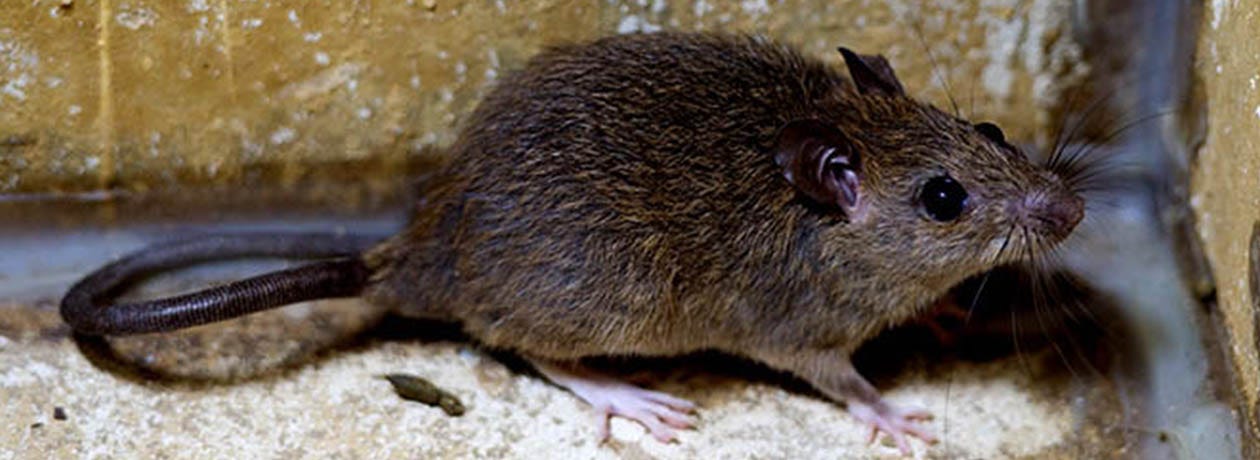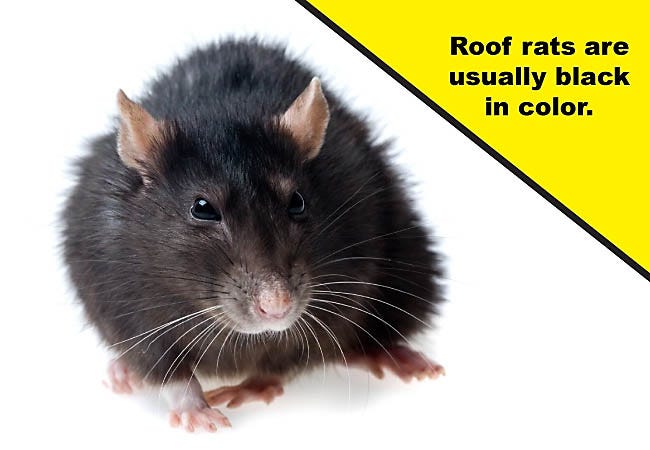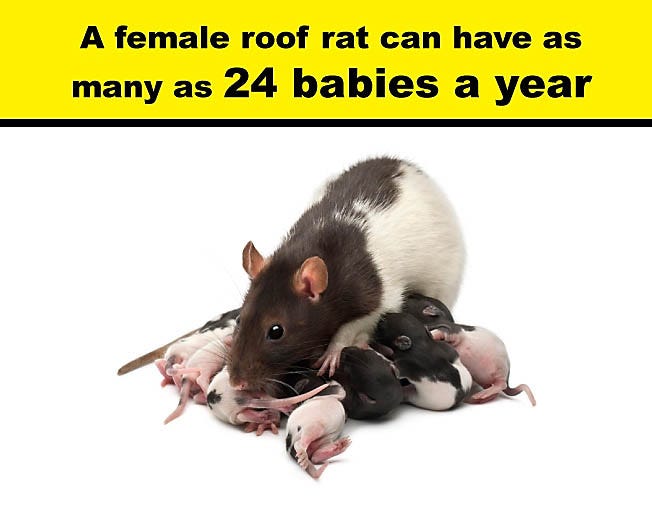How to Identify & Eliminate Roof Rats

Certain areas of the United States are more prone to rodent problems than others. One of those areas is the southern third of the United States and the coastal states, which has a problem with roof rats. If you live in these zones, your customers may complain of problems in their attic, which is a big indicator of a roof rat invasion.
To help your customers understand the best tactics for dealing with roof rats, check out these roof rat facts and control tips.
Roof Rat Information
- Other names: Palm rats, fruit rats, ship rats and Alexandrian rats.
- Size: Roof rats grow up to 18 inches (which includes the tail). They weigh about 5 oz. These rats are smaller than other common rats, and are known for their long tails.
- Appearance: Generally black in color, smooth fur with sparse hair on their faces.
- Nesting Areas: As good climbers, they build nests above ground, including trees, shrubs, wood piles and dense vegetation. Indoors, roof rats like to stay warm and they will nest in attics, cabinets, ceilings, garages, laundry rooms, patios, pool areas, inside walls and behind sheetrock
- Diet: Roof rats mainly eat nuts, seeds, vegetables and fruits, but, just like other rat species, roof rats are omnivorous. They will eat just about anything if they are hungry enough, including candle wax, insects, lizards, paper, pet and livestock food and tree bark.
- Liquids: Water sources for roof rats include air conditioning condensation drip lines, bird baths, easily chewed-through plumbing lines, irrigation lines, leaky pipes, pets’ water bowls and saucers under potted plants.

SIGNS OF AN INFESTATION OF ROOF RATS
Your customers won’t always see roof rats because they are nocturnal and forage for food at night. However, you can show them how to recognize the signs of infestation:
- Discovering roof rat droppings. The droppings are about 0.5 in long with pointed ends.
- Gnawing or scratching noises in the attic or walls.
- Gnaw marks around the roof or eaves.
- Spotting the rodents running on tree limbs, power lines, roofs, patios and in fruit trees.
- Hollowed-out fruit if you have fruit trees.
- Gnawing damage to electrical wires in the building.
- Pets and livestock showing signs of stress and agitation.
- Grease trails and marks as they travel regular routes through the building.
- Nests found in the insulation of the home or building.

HOW DO ROOF RATS GET INSIDE A BUILDING?
Let your customers know that roof rats can get into buildings in several ways, including:
- Through openings in walls, foundations, roofs, windows and the spaces created for utility lines.
- Reaching an entry point by climbing on tree branches.
- Climbing vines near the building.
- Traveling along power lines.
- Climbing rough surfaces, such as brick and concrete blocks.
WHAT DAMAGE DO ROOF RATS CAUSE?
Besides leaving droppings and urine that create a health hazard, roof rats can also cause damage to buildings. They may:
- Chew holes in soffits and eaves to gain access to the nesting sites.
- Chew on wires and causing electrical and fire hazards.
- Gnaw on wood beams in the attic.
- Chew on pipes and cause water damage.
- Trample down insulation, which decreases its usefulness.

HOW TO GET RID OF ROOF RATS
Trapping or repelling roof rats can effectively reduce the numbers of these rodents. You can offer a variety of options to your customers – from traps to repellents.
Baiting Rats
Roof rats prefer a different diet than other types of rats, so advise the use any of the following for bait:
- Dried fruit (best)
- Nuts (best)
- Berries
- Dental floss or other nesting material
- Insects
- Peanut butter
- Snail shells
- Rats are often very cautious of new food sources popping up in their surroundings. To lure them to the trap, tell your customers to bait it without setting it for a few days. The rats will then learn trust it as a safe and reliable food or nesting-material source.
Snap Traps
Snap traps from Victor® may seem like an old-fashioned way to catch rats, but they remain very effective. Point out these advantages to using snap traps:
- They're disposable.
- They’re reusable, if you so choose.
- You can use them indoors and out.
- They’re non-toxic.
- The dead rat is visible so confirming the kill is easy.
Electronic Traps
Victor® electronic traps are indoors-only, but have some great benefits:
- They are a humane and non-toxic way to deal with rats.
- They’re reusable.
- The dead rat is not visible, yet easily disposable.
- They have a blinking light to indicate a kill.
- They’re safe to use around kids and pets.
Victor® has a variety of electronic rat traps, and the best options are:
- Rat Zapper® Ultra zaps rats using 8,000 volts. A flashing red light signals a kill. The trap requires 4 D-cell batteries, and it delivers about 60 kills on one set of batteries.
- Electronic Rat Trap uses fewer volts, 7,000, but is still lethal, drawing from 4 C-cell batteries as its power source. It has a flashing green light to indicate a kill and can deliver about 50 kills per set of batteries.
- Rat Zapper® Classic runs on 4 AA-cell batteries, with about 20 kills per set of batteries. It uses 8,000 volts and has a blinking red indicator light.
Glue Traps
Glue traps do not require any baiting or setting, so they are easy to use. Just advise customers place the glue traps along the wall where rats usually travel. Victor® Hold-Fast® Rat Glue Tray uses a proprietary formula that holds the rat securely in place to prevent escape.
Ultrasonic Devices
Ultrasonic repellents work by emitting non-repetitive, high-frequency sound waves that deter rodents so they don’t enter the protected building. These are great because they are simple to use — your customer just needs to plug them in. No baiting. No setting.

THE IMPORTANCE OF SANITATION
Proper sanitation is essential in keeping roof rats from nesting in or raiding a building. Here are some good sanitation tips, which can include promoting other items in your store:
- Make sure all garbage containers have tight-fitting lids.
- Collect trash and garbage debris frequently.
- Limit pet and livestock food to no more than they eat in a day.
- Store pet and animal foods in metal containers with lids.
- Store cereals and other dry foods in air-tight containers.
- Limit access to water.
HOME AND LANDSCAPING TIPS
To reduce a property’s appeal to roof rats, tell your customers to:
- Use caulk to seal all entries that provide rodent access. They can enter through spaces that measure 0.25 in or larger
- Place screens over roof vents and attic turbine ventilators.
- Use a chimney cap or screen to protect the furnace and fireplace.
- Block entryways under sinks, near washers, dryers, dishwashers & hot water heaters.
- Always shut doors when exiting the home.
- Make sure all window screens are in good condition.
- Prune shrub and tree branches or limbs to within three feet of the structure and roof.
- Keep palm trees trimmed.
- Take down vines or shrubs growing against or near the building.
- Thin out bushes near the building.
